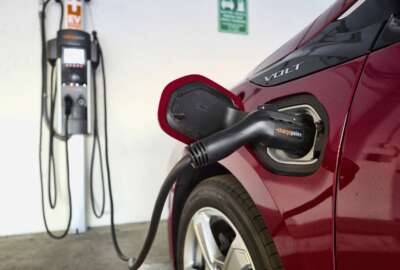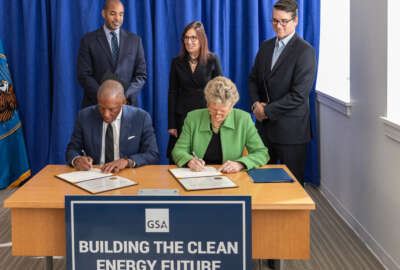GSA, Energy see ‘reasonable goal’ improving federal building efficiency within 10 years
The Energy Department and the General Services Administration see an uptick in energy savings performance contracts (ESPCs) and utility energy service contracts...
The Energy Department and the General Services Administration see an uptick in energy savings performance contracts (ESPCs) and utility energy service contracts (UESCs), while the Army, the biggest adopter of ESPCs, looks to strengthen the resiliency of its electrical grid through these smart energy projects.
A bipartisan bloc of lawmakers on the House Energy and Commerce Committee have also found common ground on the contracting vehicle federal agencies can use to upgrade their offices with energy-efficiency technology.
Through the indefinite delivery indefinite-quantity (IDIQ) contract vehicle the Energy Department’s Federal Energy Management Program (FEMP) program manages, agencies have awarded more than 400 ESPC projects, invested more than $6 billion and saved nearly $14 billion in energy costs since 1998.
In fiscal 2018 alone, agencies awarded $809 million in facility infrastructure investment, a “record year” for the contract vehicle, Leslie Nicholls, FEMP’s strategic director, told lawmakers at a Dec. 12 energy subcommittee hearing.
“We know there is an opportunity, a potential, for continued use of performance contracting,” she said.
FEMP is also developing a new framework that helps agencies identify mission risk, prioritize projects and identify financing options.
“FEMP is continuing to work with the performance contracting community to identify barriers and gaps associated with the use of performance contracting for facility-wide resilience,” Nicholls said.
Jack Surash, the Army’s acting deputy assistant secretary for energy and sustainability, said the service looks for projects that can help its facilities withstand interruptions to utilities like electricity and water.
“We’re finding those projects as very challenging to pursue, but we’re making progress there,” Surash told lawmakers.
Fort Knox achieved a major milestone in energy independence in October, when the installation passed a shutdown test, in which the Army independently stood up Fort Knox’s grid after shutting off all external power.
Through ESPCs, contractors finance the upfront cost, and certify that the upgrades will generate savings that will cover the initial cost of the project. The agency pays an annual amount to the contractor for a fixed period of time, while the contractors get paid through the energy savings achieved by agencies.
“You get taxpayer savings, you get local employment, and oh, by the way, you reduce carbon emissions,” Rep. Peter Welch (D-Vt.) said. “It’s tremendous that we’re working together on this with such bipartisan support.”
Kevin Kampschroer, GSA’s chief sustainability officer and director of the Office of Federal High-Performance Buildings said agencies that combine short and long-term projects maximize their return on investment.
“An investment in window replacement does not typically pay back in under 25 years,” Kampschroer said. “However, when you couple the window replacement with chiller and heating plant improvements, the windows may reduce the overall load in the building, reducing the size of the chiller, and saving money in a way not possible without the window replacement.”
Rep. Fred Upton (R-Mich.), the subcommittee chairman, noted Congress hasn’t revisited the legislation overseeing ESPCs and UESCs.
“Most folks would agree that it’s time to consider improvements in these programs,” Upton said. “In recent years, agencies have used ESPCs and UESCs to gather the low-hanging fruit of energy efficiency upgrades,” including lighting, insulation and heating/ventilation/air-conditioning (HVAC) projects.
Rep. Adam Kinzinger (R-Ill.) in February introduced the Energy Savings Through Public-Private Partnerships Act, which would tweak some of the requirements for ESPCs.
Currently, federal facility energy managers must evaluate and identify energy and water efficiency measures for federal facilities. However, agencies aren’t required to implement the measures.
The Kinzinger bill would require agencies to implement the smart-facility measures if they’re determined to be cost-effective.
Welch said the Democratic House majority would make Kinzinger’s bill a priority next year.
Are smart federal buildings ‘a reasonable goal?’
Rep. David McKinley (R-W.Va.), however, expressed some skepticism about the timeframe in which agencies could make their buildings energy-efficient.
“Is it reasonable to expect that we can achieve these things within 10 years?” McKinley asked.
“I think it’s a reasonable goal,” Kampschroer said.
Nicholls also agreed that 10 years made sense as a goal.
“Reasonable? I’m not sure, based upon the other needs of VA,” said Ed Bradley, the executive director of the Department of Veterans Affairs’ Office of Asset Enterprise Management. “We are building energy efficiency and energy conservation into all of our projects.”
Bradley estimated that the VA will need to spend about $50 billion to upgrade and improve VA infrastructure and facilities over the next 10 years.
“A portion of that cost would be energy efficiency — water conservation and so forth. What percentage? No idea,” Bradley said.
Across the government, agencies face a repair backlog that’s more $150 billion.
Copyright © 2025 Federal News Network. All rights reserved. This website is not intended for users located within the European Economic Area.
Jory Heckman is a reporter at Federal News Network covering U.S. Postal Service, IRS, big data and technology issues.
Follow @jheckmanWFED






